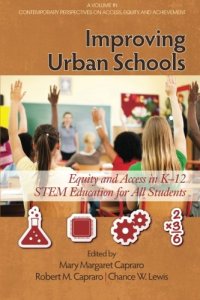
Ebook: Improving Urban Schools: Equity and Access in K-12 STEM Education for All Students
- Tags: Reference Test Preparation Almanacs Yearbooks Atlases Maps Careers Catalogs Directories Consumer Guides Dictionaries Thesauruses Encyclopedias Subject English as a Second Language Etiquette Foreign Study Genealogy Quotations Survival Emergency Preparedness Words Grammar Writing Research Publishing Higher Continuing Education Administration Adult Business School College Financial Aid Graduate Law Medical Vocational Teaching History Theory Schools STEM Curriculum Lesson Plans
- Series: Contemporary Perspectives on Access Equity and Achievement
- Year: 2013
- Publisher: Information Age Publishing
- Language: English
- pdf
Although STEM (Science, Technology, Engineering, and Mathematics) has been diversely defined by various researchers (e.g. Buck Institute, 2003; Capraro & Slough, 2009; Scott, 2009; Wolf, 2008), during the last decade, STEM education has gained an increasing presence on the national agenda through initiatives from the National Science Foundation (NSF) and the Institute for Educational Sciences (IES). The rate of technological innovation and change has been tremendous over the past ten years, and this rapid increase will only continue. STEM literacy is the power to "identify, apply, and integrate concepts from science, technology, engineering, and mathematics to understand complex problems and to innovate to solve them" (Washington State STEM, 2011, Internet). In order for U.S. students to be on the forefront of this revolution, ALL of our schools need to be part of the STEM vision and guide students in acquiring STEM literacy. Understanding and addressing the challenge of achieving STEM literacy for ALL students begins with an understanding of its element and the connections between them. In order to remain competitive, the Committee on Prospering in the Global Economy has recommended that the US optimize "its knowledge-based resources, particularly in science and technology" (National Academies, 2007, p. 4). Optimizing knowledge-based resources needs to be the goal but is also a challenge for ALL educators (Scheurich & Huggins, 2009). Regardless, there is little disagreement that contemporary society is increasingly dependent on science, technology, engineering, and mathematics and thus comprehensive understandings are essential for those pursuing STEM careers. It is also generally agreed that PK-12 students do not do well in STEM areas, both in terms of national standards and in terms of international comparisons (Kuenzi, Matthews, & Mangan, 2006; Capraro, Capraro, Yetkiner, Corlu, Ozel, Ye, & Kim, 2011). The question then becomes what might PK-12 schools do to improve teachers' and students' STEM knowledge and skills? This book will look at equity and access issues in STEM education from PK-12, university, and administrative and policy lenses.
Download the book Improving Urban Schools: Equity and Access in K-12 STEM Education for All Students for free or read online
Continue reading on any device:

Last viewed books
Related books
{related-news}
Comments (0)